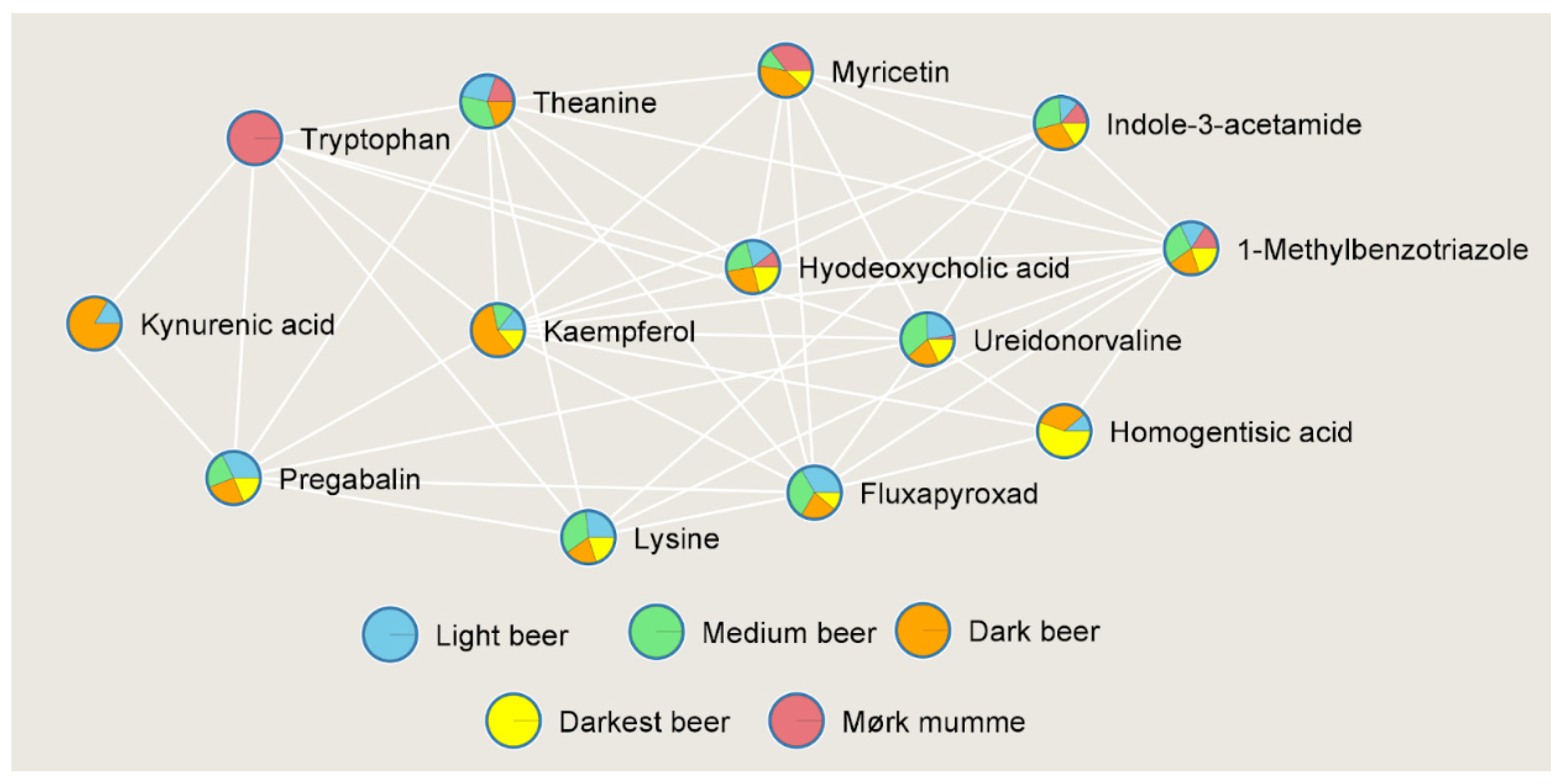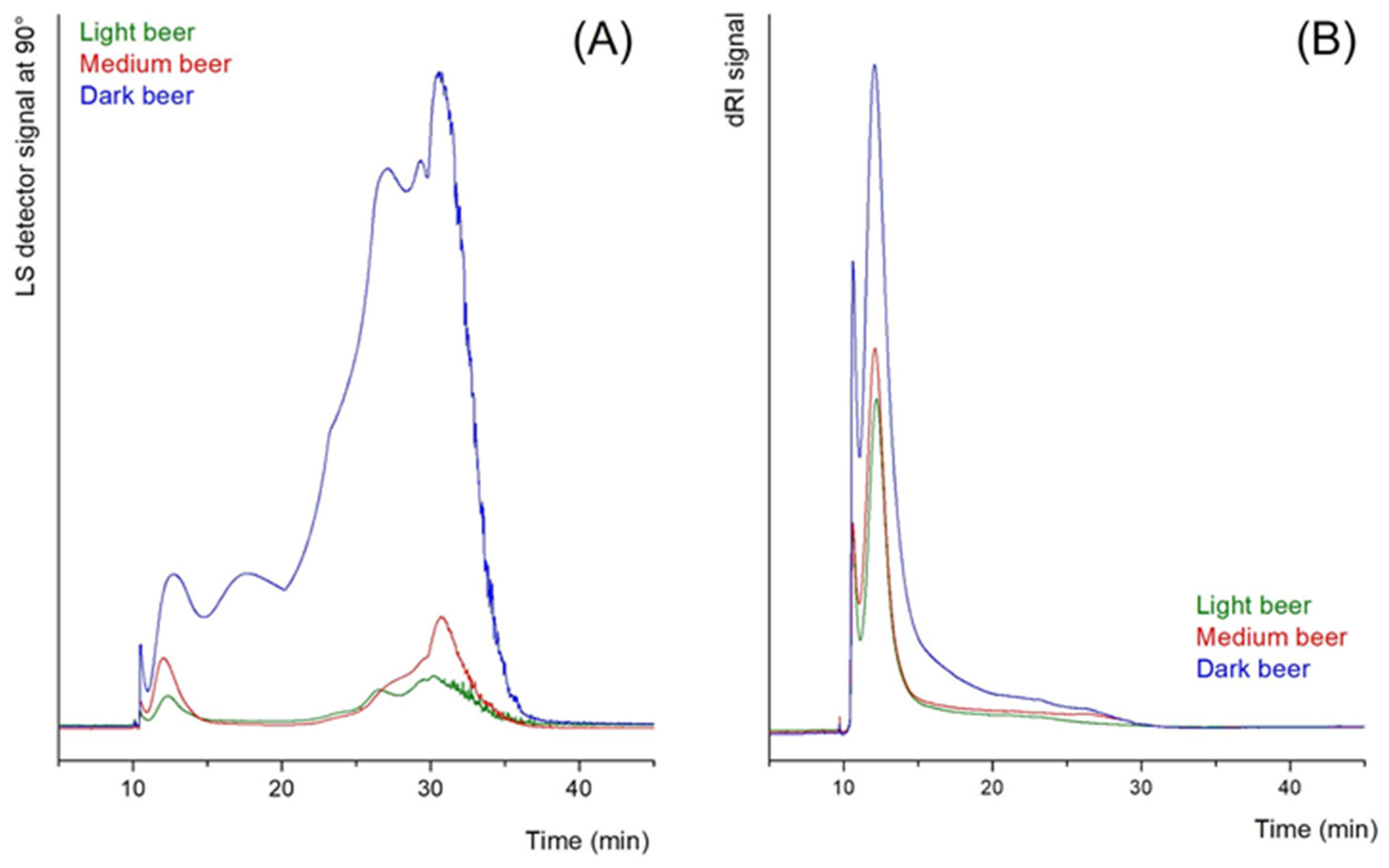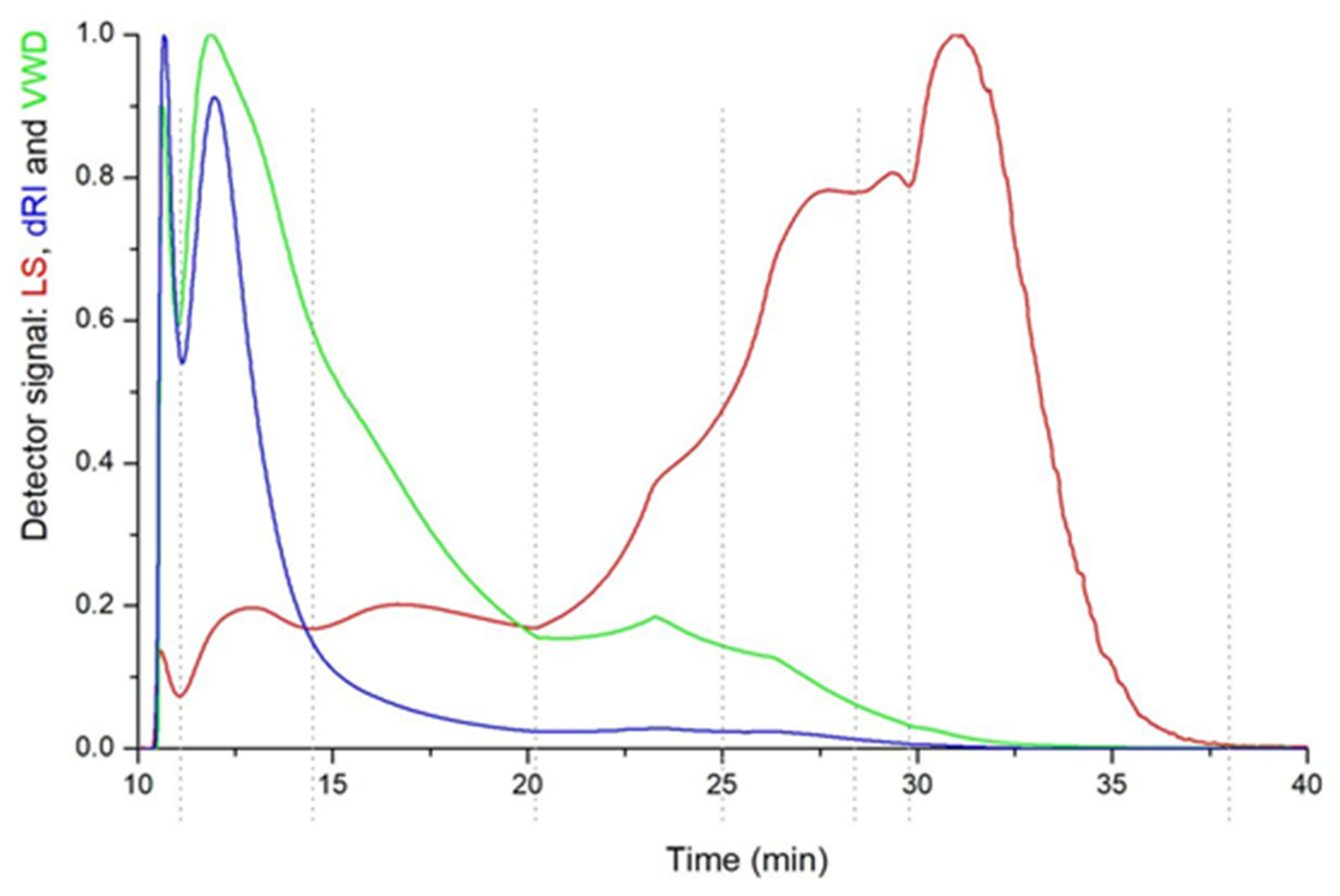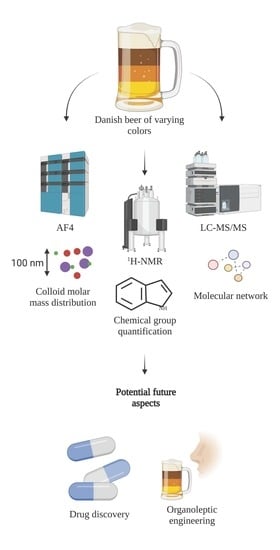Molecular Networks and Macromolecular Molar Mass Distributions for Preliminary Characterization of Danish Craft Beers
Abstract
:1. Introduction
2. Materials and Methods
2.1. LC-MS
2.2. NMR Spectroscopy
2.3. AF4-MALS
3. Results and Discussion
3.1. LC-MS and Molecular Network
3.2. NMR Analysis
3.3. Macromolecular Analysis by AF4-MALS
4. Conclusions
Author Contributions
Funding
Institutional Review Board Statement
Informed Consent Statement
Data Availability Statement
Acknowledgments
Conflicts of Interest
References
- Dabija, A.; Ciocan, M.E.; Chetrariu, A.; Codină, G.G. Buckwheat and Amaranth as Raw Materials for Brewing, a Review. Plants 2022, 11, 756. [Google Scholar] [CrossRef]
- Pieczonka, S.A.; Paravicini, S.; Rychlik, M.; Schmitt-Kopplin, P. On the Trail of the German Purity Law: Distinguishing the Metabolic Signatures of Wheat, Corn and Rice in Beer. Front. Chem. 2021, 9, 715372. [Google Scholar] [CrossRef] [PubMed]
- Zhu, L.; Hu, Z.; Gamez, G.; Law, W.S.; Chen, H.; Yang, S.; Chingin, K.; Balabin, R.M.; Wang, R.; Zhang, T.; et al. Simultaneous sampling of volatile and non-volatile analytes in beer for fast fingerprinting by extractive electrospray ionization mass spectrometry. Anal. Bioanal. Chem. 2010, 398, 405–413. [Google Scholar] [CrossRef] [PubMed] [Green Version]
- Humia, B.V.; Santos, K.S.; Barbosa, A.M.; Sawata, M.; Mendonça, M.d.C.; Padilha, F.F. Beer Molecules and Its Sensory and Biological Properties: A Review. Molecules 2019, 24, 1586. [Google Scholar] [CrossRef] [PubMed] [Green Version]
- Guo, C.; Guo, Z.; Chen, Y. A bi-end injection capillary electrophoresis method for simultaneous determination of 37 cations and anions in beers. Anal. Bioanal. Chem. 2019, 411, 4113–4121. [Google Scholar] [CrossRef]
- Fontana, M.; Buiatti, S. Amino acids in beer. In Beer in Health and Disease Prevention; Academic Press: Cambridge, MA, USA, 2009; pp. 273–284. [Google Scholar]
- Bettenhausen, H.M.; Barr, L.; Broeckling, C.D.; Chaparro, J.M.; Holbrook, C.; Sedin, D.; Heuberger, A.L. Influence of malt source on beer chemistry, flavor, and flavor stability. Food Res. Int. 2018, 113, 487–504. [Google Scholar] [CrossRef]
- Byeon, Y.S.; Hong, Y.-S.; Kwak, H.S.; Lim, S.-T.; Kim, S.S. Metabolite profile and antioxidant potential of wheat (Triticum aestivum L.) during malting. Food Chem. 2022, 384, 132443. [Google Scholar] [CrossRef]
- Buiatti, S.; Guglielmotti, M.; Passaghe, P. Industrial beer versus craft beer: Definitions and nuances. In Case Studies in the Beer Sector; Woodhead Publishing: Cambridge, MA, USA, 2021; pp. 3–13. [Google Scholar]
- Wang, M.; Carver, J.J.; Phelan, V.V.; Sanchez, L.M.; Garg, N.; Peng, Y.; Nguyen, D.D.; Watrous, J.; Kapono, C.A.; Luzzatto-Knaan, T.; et al. Sharing and community curation of mass spectrometry data with Global Natural Products Social Molecular Networking. Nat. Biotechnol. 2016, 34, 828–837. [Google Scholar] [CrossRef] [Green Version]
- Cortelo, P.C.; Demarque, D.P.; Dusi, R.G.; Albernaz, L.C.; Braz-Filho, R.; Goncharova, E.I.; Bokesch, H.R.; Gustafson, K.R.; Beutler, J.A.; Espindola, L.S. A Molecular Networking Strategy: High-Throughput Screening and Chemical Analysis of Brazilian Cerrado Plant Extracts against Cancer Cells. Cells 2021, 10, 691. [Google Scholar] [CrossRef]
- Vincenti, F.; Montesano, C.; Di Ottavio, F.; Gregori, A.; Compagnone, D.; Sergi, M.; Dorrestein, P. Molecular Networking: A Useful Tool for the Identification of New Psychoactive Substances in Seizures by LC–HRMS. Front. Chem. 2020, 8, 527952. [Google Scholar] [CrossRef]
- Hornedo-Ortega, R.; Cerezo, A.B.; Troncoso, A.M.; Garcia-Parrilla, M.C.; Mas, A. Melatonin and Other Tryptophan Metabolites Produced by Yeasts: Implications in Cardiovascular and Neurodegenerative Diseases. Front. Microbiol. 2016, 6, 1565. [Google Scholar] [CrossRef]
- Dunn, H.C.; Lindsay, R.C. Evaluation of the Role of Microbial Strecker-Derived Aroma Compounds in Unclean-Type Flavors of Cheddar Cheese. J. Dairy Sci. 1985, 68, 2859–2874. [Google Scholar] [CrossRef]
- Soh, N.L.; Walter, G. Tryptophan and depression: Can diet alone be the answer? Acta Neuropsychiatr. 2011, 23, 3–11. [Google Scholar] [CrossRef]
- Quesada-Molina, M.; Muñoz-Garach, A.; Tinahones, F.J.; Moreno-Indias, I. A New Perspective on the Health Benefits of Moderate Beer Consumption: Involvement of the Gut Microbiota. Metabolites 2019, 9, 272. [Google Scholar] [CrossRef] [Green Version]
- Cavallini, N.; Savorani, F.; Bro, R.; Cocchi, M. A Metabolomic Approach to Beer Characterization. Molecules 2021, 26, 1472. [Google Scholar] [CrossRef]
- Jastrzębska, A.; Kowalska, S.; Szłyk, E. Determination of Free Tryptophan in Beer Samples by Capillary Isotachophoretic Method. Food Anal. Methods 2020, 13, 850–862. [Google Scholar] [CrossRef] [Green Version]
- Palomino-Vasco, M.; Acedo-Valenzuela, M.I.; Rodríguez-Cáceres, M.I.; Mora-Diez, N. Automated chromatographic method with fluorescent detection to determine biogenic amines and amino acids. Application to craft beer brewing process. J. Chromatogr. A 2019, 1601, 155–163. [Google Scholar] [CrossRef]
- Witrick, K.; Pitts, E.R.; O’Keefe, S.F. Analysis of Lambic Beer Volatiles during Aging Using Gas Chromatography–Mass Spectrometry (GCMS) and Gas Chromatography–Olfactometry (GCO). Beverages 2020, 6, 31. [Google Scholar] [CrossRef]
- Oladokun, O.; Smart, K.; Cook, D. An improved HPLC method for single-run analysis of the spectrum of hop bittering compounds usually encountered in beers. J. Inst. Brew. 2016, 122, 11–20. [Google Scholar] [CrossRef] [Green Version]
- Stensballe, A. Unfiltered beer: A rich source of yeast extracellular vesicles. In Proceedings of the Third International Meeting of ISEV, Rotterdam, The Netherlands, 30 April–3 May 2014; p. 27, No. OP22-121. [Google Scholar]
- Choi, J.; Zielke, C.; Nilsson, L.; Lee, S. Characterization of the molar mass distribution of macromolecules in beer for different mashing processes using asymmetric flow field-flow fractionation (AF4) coupled with multiple detectors. Anal. Bioanal. Chem. 2017, 409, 4551–4558. [Google Scholar] [CrossRef]
- Krebs, G.; Becker, T.; Gastl, M. Characterization of polymeric substance classes in cereal-based beverages using asymmetrical flow field-flow fractionation with a multi-detection system. Anal. Bioanal. Chem. 2017, 409, 5723–5734. [Google Scholar] [CrossRef]
- Vasas, M.; Tang, F.; Hatzakis, E. Application of NMR and Chemometrics for the Profiling and Classification of Ale and Lager American Craft Beer. Foods 2021, 10, 807. [Google Scholar] [CrossRef]
- Hughes, S.S.; Nielsen, M.M.K.; Jonsbo, R.V.; Nielsen, C.U.; Lauritsen, F.R.; Prabhala, B.K. BeerMIMS: Exploring the Use of Membrane-Inlet Mass Spectrometry (MIMS) Coupled to KNIME for the Characterization of Danish Beers. Eur. J. Mass Spectrom. 2021, 27, 266–271. [Google Scholar] [CrossRef]
- Shannon, P.; Markiel, A.; Ozier, O.; Baliga, N.S.; Wang, J.T.; Ramage, D.; Amin, N.; Schwikowski, B.; Ideker, T. Cytoscape: A Software Environment for Integrated Models of Biomolecular Interaction Networks. Genome Res. 2003, 13, 2498–2504. [Google Scholar] [CrossRef]
- Turska, M.; Rutyna, R.; Paluszkiewicz, M.; Terlecka, P.; Dobrowolski, A.; Pelak, J.; Turski, M.P.; Muszyńska, B.; Dabrowski, W.; Kocki, T.; et al. Presence of kynurenic acid in alcoholic beverages—Is this good news, or bad news? Med. Hypotheses 2019, 122, 200–205. [Google Scholar] [CrossRef]
- Gouvinhas, I.; Breda, C.; Barros, A.I. Characterization and Discrimination of Commercial Portuguese Beers Based on Phenolic Composition and Antioxidant Capacity. Foods 2021, 10, 1144. [Google Scholar] [CrossRef]
- Urban, J.; Dahlberg, C.J.; Carroll, B.J.; Kaminsky, W. Absolute Configuration of Beer′s Bitter Compounds. Angew. Chem. Int. Ed. 2013, 52, 1553–1555. [Google Scholar] [CrossRef] [Green Version]
- Sommer, T.; Hübner, H.; El Kerdawy, A.; Gmeiner, P.; Pischetsrieder, M.; Clark, T. Identification of the Beer Component Hordenine as Food-Derived Dopamine D2 Receptor Agonist by Virtual Screening a 3D Compound Database. Sci. Rep. 2017, 7, 44201. [Google Scholar] [CrossRef] [Green Version]




| Brand | Type | Color | Brewery |
|---|---|---|---|
| Holbæk pilsner | Pilsner | Light | Holbæk Bryghus |
| Remise | Pilsner | Light | Ribe Bryghus |
| Vadehavsbryg | Pilsner | Medium | Ribe Bryghus |
| Vikingebryg | Bock | Medium | Ribe Bryghus |
| Porter | Porter | Dark | Ribe Bryghus |
| Dybsort porter | Porter | Dark | Ribe Bryghus |
| Nordisk hvede | Wheat | Light | Theodor Schiøtz Brewing Co |
| Gylden IPA | IPA | Medium | Theodor Schiøtz Brewing Co |
| Brown ale | Brown ale | Dark | Theodor Schiøtz Brewing Co |
| Mørk mumme | Brown ale | Dark | Theodor Schiøtz Brewing Co |
| LC Parameters | |
|---|---|
| HPLC system | Waters 2695 separations module |
| Analytical column | Waters Spherisorb ODS-2, C-18 column (15 cm, 3 µm, 4.6 mm) |
| Mobile phase A | 5% acetonitrile, 95% water, 0.1% formic acid (v/v) |
| Mobile phase B | 95% acetonitrile, 5% water, 0.1% formic acid (v/v) |
| Injection volume | 5 µL |
| Column temperature | 40 °C |
| Flow rate | 0.3 mL/min |
| MS Parameters | |
| MS system | Waters Q-TOF Premier |
| Source | Standard ESI (positive ionization) |
| Source temperature | 95 °C |
| Desolvation temperature | 250 °C |
| Desolvation gas (nitrogen) flow rate | 400 L/h |
| Cone gas (nitrogen) flow rate | 95 L/h |
| Backing gas pressure | 3 mbar |
| Collision gas (nitrogen) flow rate | 21 mL/h |
| Collision cell pressure | 4 nbar |
| Ion guide gas (nitrogen) flow rate | 1 L/h |
| Capillary voltage | 2.7 kV |
| Sampling cone voltage | 61 V |
| Extraction cone voltage | 106.5 V |
| MS scan time | 1 s |
| MS/MS scan time | 1 s |
| Interscan delay | 0.1 s |
| Collision energy ramp | 5–40 V |
| m/z range | 100–1000 m/z |
| Brand | Brewery | Indoles (μM) |
|---|---|---|
| Holbæk pilsner | Holbæk Bryghus | 69 |
| Remise | Ribe Bryghus | 111 |
| Vadehavsbryg | Ribe Bryghus | 170 |
| Vikingebryg | Ribe Bryghus | 37 |
| Porter | Ribe Bryghus | 61 |
| Dybsort porter | Ribe Bryghus | 131 |
| Nordisk hvede | Theodor Schiøtz Brewing Co | 0 |
| Bohemian pilsner | Theodor Schiøtz Brewing Co | 85 |
| Gylden IPA | Theodor Schiøtz Brewing Co | 63 |
| Brown ale | Theodor Schiøtz Brewing Co | 0 |
| Mørk mumme | Theodor Schiøtz Brewing Co | 24 |
| Color | Injection Volume (µL) | Fraction 1 (11–15 min) | Fraction 2 (25–38 min) | |||
|---|---|---|---|---|---|---|
| c (mg/mL) | Mw (kDa) | PI(Mw/Mn) | rz (nm) | rw (nm) | ||
| Light | 50 | 3.4 ± 0.4 | 9.4 ± 0.6 | 1.12 ± 0.02 | n.d. | n.d. |
| 100 | 5.1 ± 0.4 | 8.1 ± 0.6 | 1.21 ± 0.01 | 164 ± 18 | 56 ± 3 | |
| Medium | 50 | 4.1 ± 0.1 | 17.8 ± 0.5 | 1.04 ± 0.00 | n.d. | n.d. |
| 100 | 5.1 ± 0.1 | 16.7 ± 0.4 | 1.09 ± 0.00 | 122 ± 2 | 50 ± 5 | |
| ark | 50 * | 8.0 ± 0.5 | 30.7 ± 2.2 | 1.34 ± 0.04 | n.d. | n.d. |
| 100 | 10.3 ± 0.4 | 27.5 ± 0.8 | 1.47 ± 0.03 | 110 ± 3 | 36 ± 3 | |
| Peak 1 | Peak 2 | Peak 3 | Peak 4 | Peak 5 | Peak 6 | |
|---|---|---|---|---|---|---|
| Limits (min) | 11.1–14.5 | 14.5–20.2 | 20.2–25 | 25–28.4 | 28.4 + 29.8 | 29.8–38 |
| c (mg/mL) | 8.3 ± 0.2 | 1.9 ± 0.1 | 0.7 ± 0.1 | 0.4 ± 0.0 | 0.1 ± 0.0 | n.d. |
| Mw (kDa) | 29.7 ± 1.1 | 240.2 ± 12.8 | 821.2 ± 71.0 | 2681 ± 147 | 7216 ± 685 | n.d. |
| Mn (kDa) | 23.4 ± 1.1 | 195.9 ± 7.6 | 726.2 ± 71.5 | 2377 ± 131 | 6921 ± 607 | n.d. |
| PI (Mw/Mn) | 1.27 ± 0.02 | 1.23 ± 0.02 | 1.13 ± 0.01 | 1.13 ± 0.00 | 1.04 ± 1.01 | n.d. |
| Rz (nm) | n.d. | n.d. | n.d. | 19.5 ± 0.3 | 34.4 ± 0.2 | 132.8 ± 1.4 |
| Rw (nm) | n.d. | n.d. | n.d. | 16.9 ± 0.4 | 33.6 ± 0.2 | 98.92 ± 1.0 |
Publisher’s Note: MDPI stays neutral with regard to jurisdictional claims in published maps and institutional affiliations. |
© 2022 by the authors. Licensee MDPI, Basel, Switzerland. This article is an open access article distributed under the terms and conditions of the Creative Commons Attribution (CC BY) license (https://creativecommons.org/licenses/by/4.0/).
Share and Cite
Nielsen, M.M.K.; Hughes, S.S.; Kuntsche, J.; Malmendal, A.; Jenssen, H.; Nielsen, C.U.; Prabhala, B.K. Molecular Networks and Macromolecular Molar Mass Distributions for Preliminary Characterization of Danish Craft Beers. Beverages 2022, 8, 35. https://doi.org/10.3390/beverages8020035
Nielsen MMK, Hughes SS, Kuntsche J, Malmendal A, Jenssen H, Nielsen CU, Prabhala BK. Molecular Networks and Macromolecular Molar Mass Distributions for Preliminary Characterization of Danish Craft Beers. Beverages. 2022; 8(2):35. https://doi.org/10.3390/beverages8020035
Chicago/Turabian StyleNielsen, Marcus M. K., Sean Sebastian Hughes, Judith Kuntsche, Anders Malmendal, Håvard Jenssen, Carsten Uhd Nielsen, and Bala Krishna Prabhala. 2022. "Molecular Networks and Macromolecular Molar Mass Distributions for Preliminary Characterization of Danish Craft Beers" Beverages 8, no. 2: 35. https://doi.org/10.3390/beverages8020035
APA StyleNielsen, M. M. K., Hughes, S. S., Kuntsche, J., Malmendal, A., Jenssen, H., Nielsen, C. U., & Prabhala, B. K. (2022). Molecular Networks and Macromolecular Molar Mass Distributions for Preliminary Characterization of Danish Craft Beers. Beverages, 8(2), 35. https://doi.org/10.3390/beverages8020035











